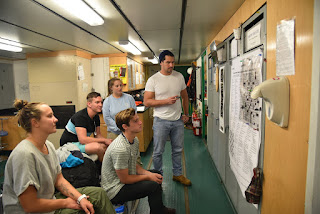CTD operations and big waves
32 30.6 S, 143 59.2 W
During our first week on the RV Nathaniel B. Palmer, we have started to settle into a rhythm. People have adjusted to their watches, found the gym, settled into their work spaces and found people to play card games, do crossword puzzles, and watch movies with. The ship has ample space for all that. Our two big dry labs are occupied by people sampling and analyzing water, and by people working on their computers. The movie room is usually occupied by somebody (science or crew) watching a movie or reading. Three comfortable chairs on the bridge are also excellent for reading (or in my case, knitting). A sign up sheet for a PingPong Tournament and Cribbage Tournament have appeared as well as a big oversized crossword puzzle on a wall that people solve together during
their breaks (see picture).
 Currently we are at Station 150, the 7th cast of our cruise), waiting out a storm and bad sea swell. So far we managed to finish 6 CTD's during mainly rough seas and winds between 20 – 30 knt. During the last two casts the waves continued to hit the ship from unaccpected angles that neither the bridge nor we could anticipated. This resulted in water, a lot of water, getting into the Baltic Room (the room from which the CTD is deployed from). Our MT's, winch operators and Mates did a fantastic job deploying the CTD and holding the ship in position. Now the storm is over but the sea is still rough with big, confused swell. Because of that we will continue waiting on station until we get the okay from the bridge and MT's to deploy the CTD. This will hopefully happen later today.
Currently we are at Station 150, the 7th cast of our cruise), waiting out a storm and bad sea swell. So far we managed to finish 6 CTD's during mainly rough seas and winds between 20 – 30 knt. During the last two casts the waves continued to hit the ship from unaccpected angles that neither the bridge nor we could anticipated. This resulted in water, a lot of water, getting into the Baltic Room (the room from which the CTD is deployed from). Our MT's, winch operators and Mates did a fantastic job deploying the CTD and holding the ship in position. Now the storm is over but the sea is still rough with big, confused swell. Because of that we will continue waiting on station until we get the okay from the bridge and MT's to deploy the CTD. This will hopefully happen later today.
CTD casts are the backbone of this trip. During cruises like this, we scientists usually work 12 hour watches, most commonly noon – midnight and midnight – noon. This allows us to do CTD operations 24 hours a day. During this leg of P6 we have five students operate the CTD, two working the night watch, three the day watch. They are assisted by our LADCP operator, and staff monitoring the CTD, data and sensors, as well as the Chief Scientist and co-Chief Scientist.
All CTD's so far have been in water of about 5000 m. It typically takes about 2 hours for the CTD to descend through the water all the way to the bottom. On the way back up, we stop at different depths to collect water samples in the attached niskin bottles. Once the CTD is back on board (after roughly 4 hours total), a group of 8 – 12 people collect water samples with one of the watch standers helping as the "sampling cop". The sample cop has to make sure nobody forgets a sample or jumps ahead. Most samples are analyzed right here on board. Usually every person takes about 36 samples per cast (with exceptions of people that are interested only in e.g. the surface water). With a total of around 110 stations planned you can do the math and figure out how much water is being analyzed in our aft-drylab!






Comments
Post a Comment